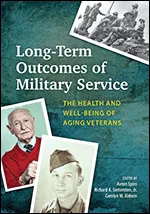Books
Center for Healthy Aging Research
Long-Term Outcomes of Military Service: The Health and Well-Being of Aging Veterans
Edited by Avron Spiro, Richard A. Settersten, Jr., and Carolyn M. Aldwin

Using data compiled from longitudinal studies of World War II, Korean War, and Vietnam War veterans, contributors to this groundbreaking book examine the effects of military service across the lifespan. The U.S. spends more than 100 billion dollars annually on healthcare for more than 30 million active military and veterans.
The prevalence of negative trauma and post-traumatic stress disorder (PTSD) among military veterans is well-known. But other more subtle effects of military service — particularly on health and well-being in later life — are less well-understood, among researchers as well as medical and mental health professionals who care for veterans.
Chapters in this book give us crucial insights into the impact of military service, including the surprising finding that service can serve as a protective factor in some contexts, throughout the aging process.
Topic areas include
- the effects of combat and stress on longevity and brain functioning
- the use of memory, cognition, and ego development at various points in life
- the relationship between experiences of discrimination and the later development of PTSD
- marriage longevity
- employment
- the way notions of patriotism and nationalism among service personnel and their families may change over time
Health, Illness, and Optimal Aging, Third Edition
Biological and Psychosocial Perspectives
AUTHORS: Carolyn Aldwin Ph.D., Diane Gilmer Ph.D., Heidi Igarashi PhD, Michael R. Levenson PhD

Uniquely bridging a gap in the gerontology literature between the biological and psychosocial aspects of aging, this interdisciplinary text provides key updates on an abundance of cutting-edge research; expands information on diversity issues in aging; and examines in great depth the physiology of aging, theories of biological aging, and methodological issues. Instructors will also welcome the availability of an Instructor’s Manual and PowerPoint slides.
Written for upper-level undergraduate and graduate students, and invigorated by the addition of new coauthors, the third edition integrates findings in biology, psychology, and the social sciences to provide comprehensive, multidisciplinary coverage of the aging process. Included is key information on age-related changes and disease-related processes, the demography of the aging population worldwide, theories of aging, and ways to promote optimal aging. From a psychosocial perspective, the book examines mental health, stress and coping, spirituality, and caregiving in later years. Also included is crucial information on longitudinal design and statistics as they relate to research on aging, promising new trends in gerontechnology and Green Houses, and information on health promotion programs. Real-life examples throughout the text help students to understand practical applications of the material.
New to the Third Edition:
- Abundant new cutting-edge research on biological and psychosocial aspects of aging
- Expands information on diversity issues
- Updated theories of biological aging: microRNA, proteasomes, and gut microsomes Psychology of aging: How variability in responses to stress affects health and mortality
- Aging and public policy: How the recent recession has affected poverty rates resulting in increases in mortality among poor, middle-aged Whites
- Gerontechnology: The “Internet of things,” assistive devices, and the potential of robots
- Instructor’s Manual and PowerPoint slides
Key Features:
- Examines age-related changes, disease-related processes, theories of aging, and ways to promote optimal aging
- Encompasses mental health, stress and coping, spirituality, and caregiving in later years
- Provides information on aging-related longitudinal design and statistics
- Covers promising new trends such as gerontechnology and Green Houses